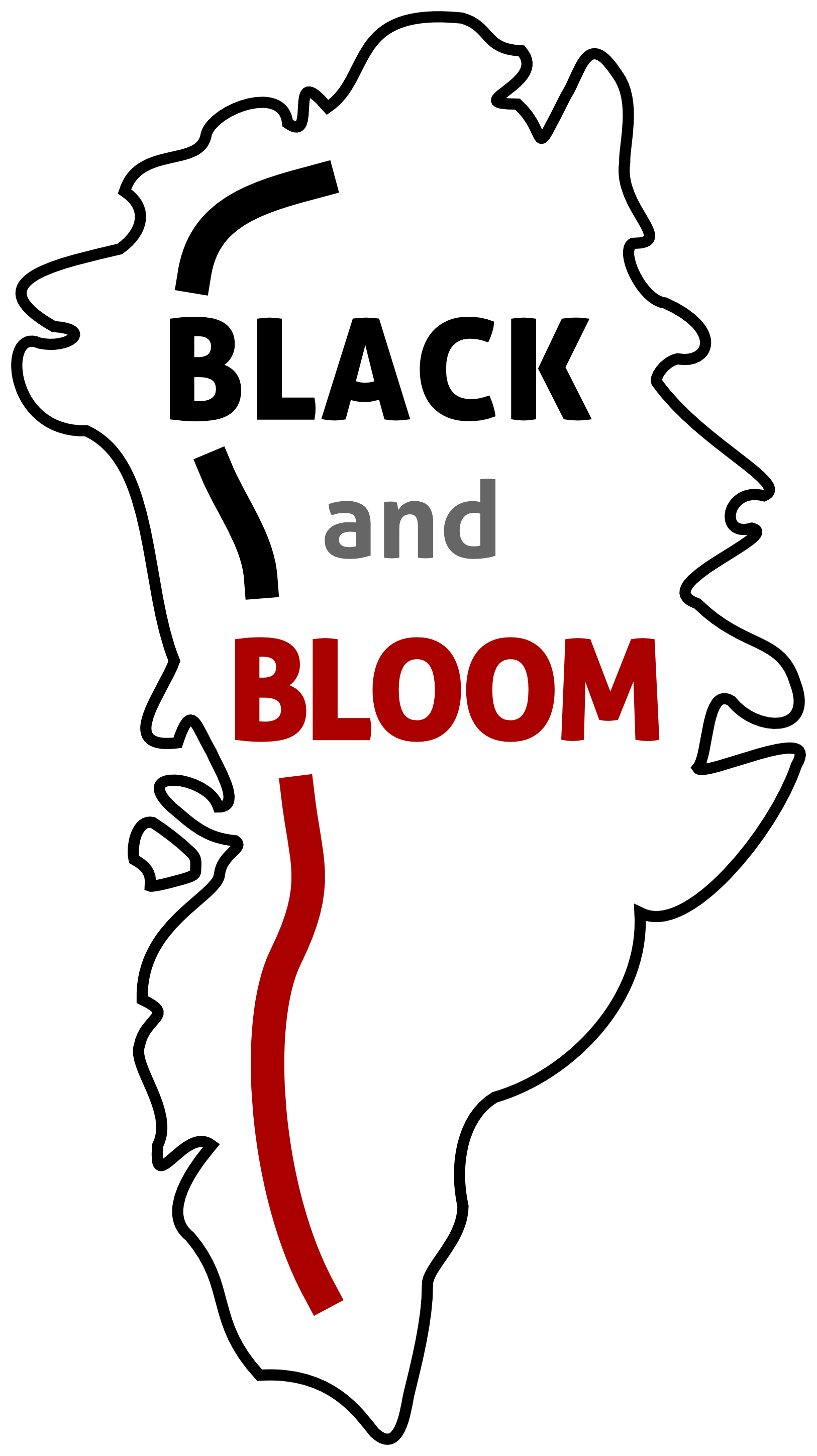Project Background
Black and Bloom brings together an interdisciplinary team of scientists to tackle the questions surrounding the accelerating melt of the Greenland Ice Sheet. Melt and runoff have steadily increased since 1992 by a magnitude that cannot be explained by climate change alone. The focus of the increased melt is the SW margin of the ice sheet, where a reduction in the reflectivity (or ‘albedo’) of the surface ice has also been noted over the last 30 years. Albedo is a crucial factor that controls the melt of ice surfaces.
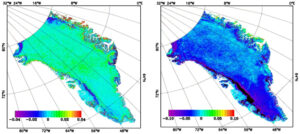
The maps above show (a) Decadal July albedo change rate over Greenland from GLASS products in 1981–2000; (b) decadal July albedo change rate over Greenland from GLASS products in 2000–2012. Darkening has been particularly clear since 2000, especially along the western coast. Figure courtesy of He et al. (2013, Env. Res. Lett.) reproduced under the Creative Commons Attribution 3.0 License.
It is known that small amounts of debris such as soot (or ‘black carbon’) from wild fires or anthropogenic sources, can have a major effect on ice albedo in the ablation zone, where meltwater is produced. Such ‘contaminants’ effectively darken the surface, and thus lower the albedo. Given that dark surfaces absorb more of the sun’s heat than highly reflective clean ice or snow, the darkening results in increased melt.
In addition to dark particles, there is also a growing realisation that micro-organisms, which grow and thrive in surface melt water, also contribute to albedo reduction. Many of these organisms are photosynthetic and use pigments, such as chlorophyll, to capture sunlight and grow. In polar regions that have a high amount of UV, photosynthetic organisms also produce specialist UV protecting pigments (i.e. sun-block) for protection. These pigments, in addition to the dark particles, can significantly darken the surface of the ice sheet, further increasing melt.
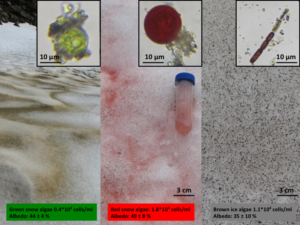
Over the next 4 years, Black and Bloom will run several field expeditions to the ‘dark-zone’ along the western margin of the Greenland Ice Sheet (the area where albedo reduction has been the greatest) to determine how particles and microorganisms are affecting albedo and melt under current climate conditions. We’ll then use the data we generate to make predictions about the melt and stability of the ice sheet under future climate scenarios, so that we can understand how things such as sea level rise will progress in the future.
To do this, we’ve divided our science into 4 working packages that inter-connect to allow us to take observations and make predictions from the scale of single particles and cells, up to the extent of the entire ice sheet.
Working Package 1 – The Microbiology
Despite their importance, we currently know very little about the bacteria and algae that live on ice sheet surfaces. For example, we’re not sure how these communities change over the course of summer melt seasons, or what is ultimately controlling their growth and distribution. Given that direct links have been made between albedo reduction and the number of pigmented bacteria and algae living in ice surfaces, it will be crucial to understand the ‘ecology’ of these communities if we are to understand and predict how they will contribute to albedo – the so-called ‘bio-albedo’.
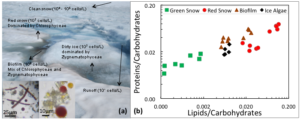
Modified from Lutz et al. (2014).
WP1 will therefore examine the growth and evolution of microbial communities on the surface of the Greenland Ice Sheet across a range of different surface habitats, including snow, slush, ice and cryoconite holes. We’ll measure how many bacteria and algae live in these different ice habitats, and how this changes over summer melt seasons. While doing this, we’ll be able to monitor background conditions, e.g. temperature, sunlight and nutrient concentrations, and use this data to determine what is controlling the communities’ growth and survival. We’ll also be taking samples to accurately measure the pigments that the bacteria and algae produce, so that we can directly link this to albedo measurements made by other working packages.
WP2 – The Particles
Anthropogenic activity has led to an increased deposition of particles on the Greenland Ice Sheet since the industrial revolution, and we think that this too has resulted in elevated biological activity and enhanced ice sheet melting. However, whilst we know that dark particles such as black carbon can cause ice albedo to reduce and melt to increase, field measurements of the number or type of particles arriving on the ice sheets are currently sparse.
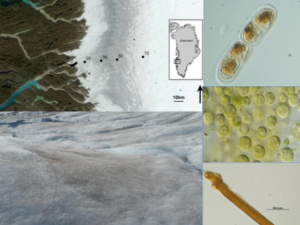
Importantly, the microorganisms that grow on snow and ice are also known to bind to and interact with the particles present. We think that this can serve to retain the particles on the ice surface, further contributing to albedo reduction. At the same time, the organisms themselves may benefit from the presence of the particles, potentially mining them for important nutrients.
WP2 will thus characterise and quantify the particles present across the different Greenland Ice Sheet environments, over summer melt seasons. Building on the work of WP1, we will also document organism-particle interactions, and seek evidence for the mining of nutrients from the particles by the microorganisms.
One of the main methods we will use to meet the aims of WP2 is continuous, in-situ measurements of black carbon and aerosol size distribution near the Black and Bloom principal ice camp. We’ll also be using a variety of filter sampling systems to collect ambient air samples for analysis back in the UK. The pristine environment that we expect to encounter out on the ice sheet will likely make this sampling particularly challenging!
WP3 – The Albedo
The albedo of ice surfaces is a crucial factor controlling the rate at which they melt, and results from complex interactions between water accumulation, dust and soot deposition, and algal growth. WP3 combines with WP1 and WP2 to determine albedo variations in the field, and to attribute them to various physical and biological effects. We are responsible for measuring the albedo over time and deepening our understanding of albedo feedbacks on the ice surface.
The science of WP3 will thus include detailed measurements of reflectance across the electromagnetic spectrum (‘spectral reflectance’), and quantification of the impact of various albedo-reducing processes. We will also be developing radiative transfer models tuned to our field data that can be used to predict albedo for a range of future climate scenarios.
To deliver our objectives, WP3 will use a combination of surface measurements, ice coring, and UAV flights over the ice sheet. We’ll also be returning numerous samples back to our laboratory in Sheffield for deep analysis.
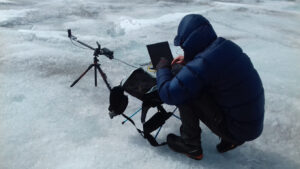
WP3 using the ASD FieldSpec spectrometer to measure albedo
WP4 – The Scaling-Up and Modelling
Tremendous advances have been made over the last decade in modelling the evolution of the Greenland Ice Sheet surface mass balance, i.e. the net balance between processes of gain (‘accumulation’) and loss (‘ablation’) of the ice sheet’s surface. Albedo is the single most critical component in the energy balance in summer, when melt takes place, as this determines the amount of solar radiation absorbed/reflected.
Albedo is typically calculated empirically, however, such calculations are currently based on limited data, and are likely unrepresentative with on-going climate change. Importantly, still missing from these calculations is the impact of biota, i.e. bio-albedo, on melt rates. Until Black and Bloom, this was due to a lack of detailed field data sets.
WP4 will bring together all of the three other working packages, linking all field and laboratory measurements, in addition to large-scale satellite imagery of albedo change, to incorporate bio-albedo into state-of-the-science models of snow and ice melt. This will allow us to make 21st century projections of surface melt under future climate scenarios developed by the Intergovernmental Panel on Climate Change (IPCC).
